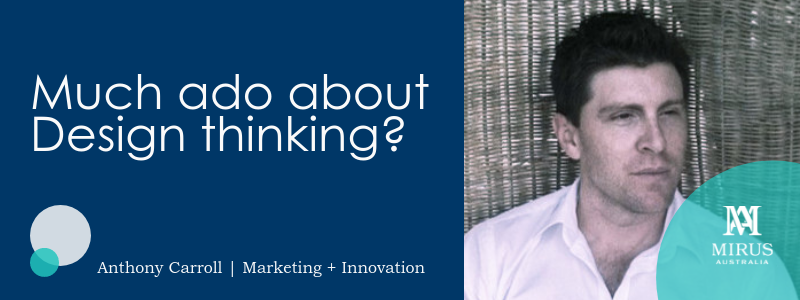Much ado about Design thinking? with Anthony Carroll
February 19, 2019 | Aged Care Management

In business, we are constantly presented with new ways of doing something. Whether it’s the latest marketing trend or a whole new business model, it can be quite easy to get bamboozled with the latest idea or methodology.
There has been a lot of talk about Design thinking. Companies and organisations such as IDEO, Stanford University, University of Sydney and our own organisation, Mirus Australia have all been talking about Design thinking as a new way of doing things in business. And it seems that a lot of businesses and organisations throughout the world are now adopting it as a way to develop new products, services, processes, and strategies.
“A methodology for innovation that combines creative and analytical approaches and collaboration across disciplines.” – d.school, Stanford University
So, what is Design thinking?
The term “Design thinking” refers to the process someone would take when looking to create a new idea or solve a problem. It allows you to combine ‘right-brained’ creative thinking with ‘left-brained’ analytical thinking. Design thinking offers a process and a set of tools for our decision-making process while ensuring the organisation runs effectively and efficiently.
A new idea or passing fad?
Design thinking isn’t necessarily a new idea. The notion of design as a ‘way of thinking’ can be traced back to Herbert A. Simon’s 1969 book, ‘The Sciences of the Artificial’. In Peter Rowe’s book, ‘Design Thinking’, he describes it as methods and approaches that are used by architects and urban planners. During the 1980s, Rolf Faste started teaching “design thinking as a method of creative action” at Stamford University. And in 1991, David M. Kelley, a Stanford colleague of Faste’s and founder of IDEO adapted Design thinking for business.
“You’ve got to start with the customer experience and work back toward the technology – not the other way around“ – Steve Jobs
Start with the customer first
At the core of Design thinking is what we call a ‘human-centered’ approach. There has been a tendency for companies and organisations to be very product orientated but forget about the customer or end-user in the process.
Design thinking/Human-centred design forces you to start with the customer (or end user) first and develop ideas or solutions based on insights from their perspective. Empathy is the key driving force behind Design thinking. When we can put ourselves in the shoes of our customers, we get a much better understanding of their needs.
Thinking as a process
Contrary to belief, creativity needs to have a structure around it for it to be effective. When there is no structure or process, our thinking becomes wayward and unfocused. By using a Design thinking approach, it enables people who aren’t trained as designers to use creative tools to address a vast range of challenges and generate viable solutions.
“Empathy > Define > Ideation > Prototyping > Test”
There are different Design thinking methods, which have been developed. Stanford’s d:school uses five key elements in their Design thinking process; Empathy > Definition > Ideation > Prototyping > Test.
This process can be used to create solutions based on customer/end-user insights. Both Stanford and IDEO couple this approach with three key factors; (human) desirability, (technological) feasibility and (commercial) viability.
“Fall in love with the problem” – Ash Maurya, Lean Stack
Fall in love with the problem
All too often, people go into solution mode before they fully understand the problem or challenge the customer is experiencing. This can lead to implementing a solution that doesn’t actually solve the problem. So, before you start the process of finding a solution, you need to fall in love with the problem first.
Quite often the perceived problem can actually be something else entirely. It’s important to gain insights first from those experiencing it firsthand. And then either confirm or redefine the problem statement for the customer. This can only be done through customer insights and research e.g. usage data, face to face interviews. The understand or discovery phase sets the tone and direction for finding the right solution to the right or clearly defined problem.
Where innovation is found
Life is too short to be creating something that nobody wants to buy or use. By applying a customer/user-centric approach for your organisation, you are ensuring your products and services remain desirable, feasible and viable in a constantly changing world. Solutions are found when you focus on the needs of others. And empathy is the key to unlocking those crucial customer insights.
About the author: Anthony Carroll provides facilitation and training in Design thinking/Human-Centred design for organisations. Design thinking enables organisations to adopt a customer-centered approach to solving problems and challenges, leading to innovation and better customer experiences. Anthony is also a senior member of the Mirus Marketing Team. For more information on Mirus Marketing including Design thinking / Human-Centered design, please click here. To connect with Anthony on Linkedin, please click here.


